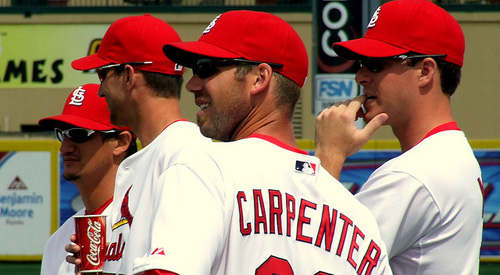
Do the Cardinals have enough pitching to make a run in 2011?
A lot has been said about the St. Louis Cardinals’ offense this year. While Albert Pujols isn’t showcasing his typical dominance, Lance Berkman and Matt Holliday are picking up the slack and keeping the Cardinals right in the thick of the NL Central race.
It’s hard to deny that hitting has been the reason for the Cardinals’ success so far. Currently, the Cardinals are ranked fifth in the majors in runs scored, third in both batting average and on-base percentage, and eighth in slugging percentage.
But despite the level of comfort that comes from a successful offense, pitching is what wins ball games. With the huge hole left in the Cardinals’ starting rotation with the absence of Adam Wainwright, is St. Louis’ pitching good enough to push them deep into the postseason?
Any team intent on making a significant playoff run had better have a quality pitching staff, both confident and capable. When Wainwright was forced to undergo Tommy John surgery over the offseason, one of the National League’s premier pitching suffered an unexpected hit. Over the past few years, Wainwright had proven to be a dominant force on the mound and perennial Cy Young candidate.
Wainwright broke into the Majors as a 24-year-old and began in the bullpen, by 2007 he had become a full-fledge starter. Since then, his ERA has consistently shrunk each season, from 3.70 in 2007 down to 2.42 in 2010. His improvement as a pitcher is even more noticeable when looking at his WHIP over those four seasons: 1.40, 1.18, 1.21, and 1.05. With those kinds of numbers, on top of the fact that Wainwright logged 463 innings in the last two years, the Cardinals had their work cut out for them in finding a serviceable replacement for their ace.
It took the 2007 trade of Jeff Suppan to the Brewers for the Cardinals to slide Wainwright into the rotation; in 2011 they’ve promoted from within yet again, bringing in Kyle McClellan out of the pen and into the starting rotation in place of Wainwright.
[php snippet=1]
McClellan’s numbers had been decent out of the bullpen – a career 3.54 ERA, 1.29 WHIP, and 6.22 K/9 over 3 seasons – with a stellar 2010 campaign where he finished with a 2.27 ERA and 1.08 WHIP. The question was, could McClellan’s success translate in his first year in the starting rotation? In almost all cases prior, the answer was no. Simply put, it’s too much to expect a pitcher who typically throws around 80 innings out of the pen to put up a similar stat line when pitching almost three times that amount as a starter.
Through the halfway point this season, McClellan has tossed 97.2 innings, already surpassing his previous season-high of 75.2. His stats won’t blow anyone away (4.24 ERA and 1.33 WHIP) and he’s run into some trouble late in the season that he avoided early on, giving up 13 runs in his last 18 innings. All things considered, McClellan’s first year in the rotation can be classified as rocky, and judging by historical data, you wouldn’t expect a huge swing from him in the second half of the season. Clearly McClellan is no Wainwright, but he has filled in adequately.
So with the Wainwright-to-McClellan switch, the once dominant Cardinals rotation currently sits 19th in ERA, 24th in quality starts, 17th in WHIP, and 23rd in batting average against. Once Wainwright went down, a lot of the pressure to keep the Cardinals in winnable games fell on the broad shoulders of 36-year-old Chris Carpenter.
Carpenter, by all accounts has had an off year so far. His record sits at 4-7 with a 3.85 ERA and 1.33 WHIP. While his velocity has actually increased this year in comparison to years past, his horizontal and vertical movement hasn’t been as great. His breaking balls aren’t breaking as much. It’s tough to pinpoint the reason behind it. Carpenter is 36 now, so it’s possible his window of opportunity is closing. It’s also possible that Carpenter is overworked, or rather, was overworked last year and is still suffering from it.
One thing is for sure: Carpenter has been an absolute monster on the mound when he has been healthy over the past decade. Even though he’s always on the top of innings pitched category, he’s been extremely efficient on the mound, and a case could be made that his innings pitched aren’t an accurate measuring stick for him. If you look at the raw stats for a healthy Carpenter, you’ll notice he’s actually been very consistent. Since joining the Cardinals in 2004, the man has posted a WHIP of at least 1.18 or lower in every season he has pitched, so his jump to a 1.33 WHIP this season is shocking and unexpected.
Here’s where the hope part fits in if you’re a Cardinals fan. Carpenter has shown he can carry a strong workload throughout his career if he remains healthy, just as well, he’s been fairly consistent in a Cardinals uniform. Where a swing in McClellan’s stats is unlikely, a swing in Carpenter’s could be right around the corner.
Throw in the fact that Jamie Garcia has a rotation-best 3.22 ERA and Kyle Lohse has a low 1.06 WHIP and that hope grows. Both Garcia and Lohse putting in commendable campaigns as the second and third starters in what was once an uncertain rotation.
If Carpenter can figure things out, the Cardinals have all the pitching ingredients to complement their more-than-adequate hitting. Not bad for a franchise lacking their ace.
[php snippet=1]

